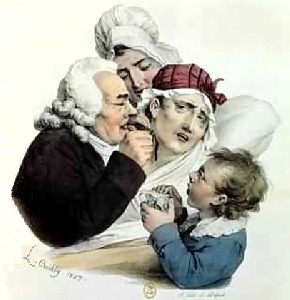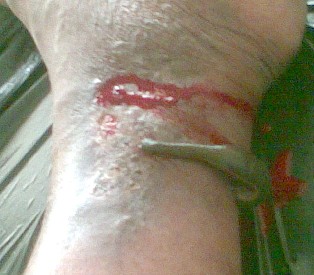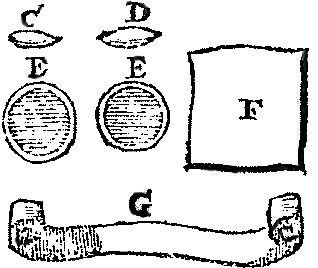
Leeches in Medicine Page Selection Menu: 1 2 3 4 5 Next>>
Leeches in Medicine During the Golden Age of Piracy, Page 4
Leech Application: Removal
Pierre Dionis notes that leeches "don't quit their hold before they are satiated; if they fall

A physician working with his leeches from an
image by L. Boilly (1827)
off too soon, we apply others to the same Orifices."1 So, in essence, if you want to remove so many leeches worth of blood the process is simple. They happen to be wonderfully self-regulating and will just drop off when they are full and go into their six month coma or whatever it is once they are full.
If you want to remove them before they are full (or you are one of those heartless surgeons who have lopped off their tails so that they keep at it in an attempt to fill the endless void you have created for them), you have to use more heroic means. Dionis advises us in this matter. "When we believe we have drawn Blood enough, we are not to tear off the Leaches, lest they should leave their Stings behind them [Note: as we have already established, medicinal leeches do not have stings, they have three blades composed of hundreds of small teeth. We must forgive Monsieur Dionis his ignorance in this matter.]: But to make them quit their hold, lay a little Salt-petre or Salt on their Back, and they will loosen immediately."2 John Atkins gives us some other suggestions, explaining that "when you would have them leave off Suction, sprinkle a little salt Ashes, Aloes, or Vinegar at their Heads."3

An ankle-biting leech leaving the site once full
Once the leech is removed, Ambroise Paré offers yet another curious observation. "If anie desire to know how much blood they have drawn, let him sprinkle [the leeches] them with salt made into powder, as soon as they are com off for thus they will vomit up what blood soever they have sucked."4 M. Paré clearly does not have the leech's better interests in mind! First he wants to amputate the leech's tail so that it can't get full, then he wants to make the poor thing barf up its dinner.
He does offer a suggestion to save the unfortunate leeches from any further abuse on his part. "After the Leech, beeing filled with blood, shall fall off, if the diseas require a large evacuation of blood, and the part affected may endure it, Cupping-glasses, or Horns, or other Leeches shall bee substituted."5 This takes advantage of anticoagulant the leech used to keep the wound bleeding. You may recall from page 2 of this treatise that the wound will continue to bleed for some time after the leech quits its hold and the cupping glass can encourage even more bleeding.
1 Pierre Dionis, A course of chirurgical operations: demonstrated in the royal garden at Paris. 2nd ed., p. 476; 2 Ibid., p. 476; 3 John Atkins, The Navy Surgeon, p. 182; 4 Ambroise Paré, The Workes of that Famous Chirurgion Ambrose Parey, p.445; 5 Ibid.
Leech Application: Stopping Bleeding
Of course the anticoagulant cuts both ways.

Surgeon Ambroise Paré - Notice how
the eyes follow you everywhere?
Since the wound continues to bleed once the leech has been removed, it is up to the surgeon who put them there to stop the blood loss if the patient has been bled enough. Ambroise Paré addresses this problem by explaining "If you cannot stop the bleeding after the falling away of the Leeches, then press the half of a bean upon the wound, until it stick of it self, for thus it will stay; also a burnt rag may bee fitly applied with a bolster and fit ligature."1 You really have to give this man points for originality when it comes to the use of medicinal leeches.
Still, this is preferable to the technique used by a surgeon described by John Atkins in his book. Atkins tells us that his peer Mr. Turner "was forced to use the actual Cautery [burning with hot cautery irons] to a Child he had apply'd leeches to."2 Cauterizing would certainly have stopped the bleeding. Half a bean isn't sounding quite so far out there any more now, is it?

The bandages required for post-leech care taken from
"A course of chirurgical operations" by Pierre Dionis, p. 475
Normally, such drastic measures aren't required. Atkins advises that in normal leech use the surgeon "let the Blood continue issuing a little, and then wash the Part clean with warm Wine, Milk and Water"3, suggesting that the wound will usually stop bleeding of its own accord. Pierre Dionis agrees that the wound should be allowed to run for a bit, "that no Venom may remain behind." Of course, there really isn't any venom, but we'll again allow M. Dionis his error in this matter. He goes on in his usual explicit fashion to provide more useful advice; "we are to wash the Punctures with Salt-water, and if the Blood does not stop of it self, we are to lay on a little scrap'd Lint C, or burnt Linen D. We may lay on the Plaisters E E, a little Bolster F, and a Band G, rolled at both ends."5
1 Ambroise Paré, The Workes of that Famous Chirurgion Ambrose Parey, p.445; 2 John Atkins, The Navy Surgeon, p. 182; 3 Ibid.; 4 Pierre Dionis, A course of chirurgical operations: demonstrated in the royal garden at Paris. 2nd ed., p. 476; 5 Ibid., p. 476-7

